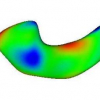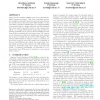2031 search results - page 69 / 407 » Non-symmetric Support Vector Machines |
ICPR
2004
IEEE
14 years 9 months ago
2004
IEEE
Support vector machines (SVMs) have become one of the most promising techniques for relevance feedback in content-based image retrieval (CBIR). Typical SVM-based relevance feedbac...
ISBI
2008
IEEE
14 years 8 months ago
2008
IEEE
The Support Vector Machine (SVM) is a powerful tool for classification. We generalize SVM to work with data objects that are naturally understood to be lying on curved manifolds, ...
KDD
2002
ACM
14 years 8 months ago
2002
ACM
Support vector machines (SVMs) excel at two-class discriminative learning problems. They often outperform generative classifiers, especially those that use inaccurate generative m...
OSDI
2008
ACM
14 years 8 months ago
2008
ACM
Mitigating the impact of computer failure is possible if accurate failure predictions are provided. Resources, applications, and services can be scheduled around predicted failure...
ICPR
2010
IEEE
14 years 2 months ago
2010
IEEE
We present a method that automatically detects chewing events in surveillance video of a subject. Firstly, an Active Appearance Model (AAM) is used to track a subject’s face acr...


